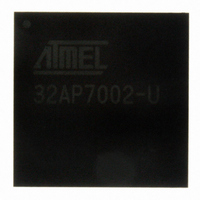AT32AP7002-CTUT Atmel, AT32AP7002-CTUT Datasheet - Page 231

AT32AP7002-CTUT
Manufacturer Part Number
AT32AP7002-CTUT
Description
IC MCU 32BIT AVR32 196-CBGA
Manufacturer
Atmel
Series
AVR®32 AP7r
Specifications of AT32AP7002-CTUT
Core Processor
AVR
Core Size
32-Bit
Speed
150MHz
Connectivity
EBI/EMI, I²C, MMC, PS2, SPI, SSC, UART/USART, USB
Peripherals
AC'97, DMA, I²C, LCD, POR, PWM, WDT
Number Of I /o
85
Program Memory Type
ROMless
Ram Size
32K x 8
Voltage - Supply (vcc/vdd)
1.65 V ~ 1.95 V
Data Converters
D/A 2x16b
Oscillator Type
Internal
Operating Temperature
-40°C ~ 85°C
Package / Case
196-CBGA
Data Bus Width
32 bit
Data Ram Size
32 KB
Interface Type
I2C, JTAG, PS2, SPI, SSC, UART, USART, USB
Maximum Clock Frequency
150 MHz
Number Of Timers
3
Maximum Operating Temperature
+ 85 C
Mounting Style
SMD/SMT
Minimum Operating Temperature
- 40 C
On-chip Dac
16 bit, 2 Channel
Package
196CTBGA
Device Core
AVR32
Family Name
AT32
Maximum Speed
150 MHz
Operating Supply Voltage
1.8|3.3 V
For Use With
ATAVRONEKIT - KIT AVR/AVR32 DEBUGGER/PROGRMMRATNGW100 - KIT AVR32 NETWORK GATEWAYATSTK1000 - KIT STARTER FOR AVR32AP7000
Lead Free Status / RoHS Status
Lead free / RoHS Compliant
Eeprom Size
-
Program Memory Size
-
Lead Free Status / Rohs Status
Details
Available stocks
Company
Part Number
Manufacturer
Quantity
Price
- Current page: 231 of 896
- Download datasheet (13Mb)
18.4
18.4.1
18.4.2
18.4.3
18.5
18.5.1
32054F–AVR32–09/09
Product Dependencies
Functional Description
Power Management
Interrupt
Peripherals
Configuration
The PDC clock is generated by the Power Manager. The PDC also depends on the HSB-HSB
bridge clock. Before using the PDC, the programmer must ensure that the PDC clock and HSB-
HSB bridge clock are enabled in the Power Manager.
To prevent bus errors the PDC operation must be terminated before entering sleep mode
The PDC has an interrupt line for each channel connected to the Interrupt Controller via the cor-
responding peripheral. Handling the PDC interrupt requires programming the interrupt controller
before configuring the PDC.
Before using each PDC channel the corresponding peripheral has to be configured correctly.
The PDC channels user interface enables the user to configure and control the data transfers for
each channel. The user interface of a PDC channel is integrated into the user interface of the
peripheral (offset 0x100), which it is related to.
Per peripheral, it contains four 32-bit Pointer Registers (RPR, RNPR, TPR, and TNPR) and four
16-bit Counter Registers (RCR, RNCR, TCR, and TNCR).
The size of the buffer (number of transfers) is configured in an internal 16-bit transfer counter
register, and it is possible, at any moment, to read the number of transfers left for each channel.
The memory base address is configured in a 32-bit memory pointer by defining the location of
the first address to access in the memory. It is possible, at any moment, to read the location in
memory of the next transfer and the number of remaining transfers. The PDC has dedicated sta-
tus registers which indicate if the transfer is enabled or disabled for each channel. The status for
each channel is located in the peripheral status register. Transfers can be enabled and/or dis-
abled by setting TXTEN/TXTDIS and RXTEN/RXTDIS in PDC Transfer Control Register. These
control bits enable reading the pointer and counter registers safely without any risk of their
changing between both reads.
The PDC sends status flags to the peripheral visible in its status-register (ENDRX, ENDTX,
RXBUFF, and TXBUFE).
ENDRX flag is set when the PERIPH_RCR register reaches zero.
RXBUFF flag is set when both PERIPH_RCR and PERIPH_RNCR reach zero.
ENDTX flag is set when the PERIPH_TCR register reaches zero.
TXBUFE flag is set when both PERIPH_TCR and PERIPH_TNCR reach zero.
These status flags are described in the peripheral status register.
AT32AP7002
231
Related parts for AT32AP7002-CTUT
Image
Part Number
Description
Manufacturer
Datasheet
Request
R

Part Number:
Description:
DEV KIT FOR AVR/AVR32
Manufacturer:
Atmel
Datasheet:

Part Number:
Description:
INTERVAL AND WIPE/WASH WIPER CONTROL IC WITH DELAY
Manufacturer:
ATMEL Corporation
Datasheet:

Part Number:
Description:
Low-Voltage Voice-Switched IC for Hands-Free Operation
Manufacturer:
ATMEL Corporation
Datasheet:

Part Number:
Description:
MONOLITHIC INTEGRATED FEATUREPHONE CIRCUIT
Manufacturer:
ATMEL Corporation
Datasheet:

Part Number:
Description:
AM-FM Receiver IC U4255BM-M
Manufacturer:
ATMEL Corporation
Datasheet:

Part Number:
Description:
Monolithic Integrated Feature Phone Circuit
Manufacturer:
ATMEL Corporation
Datasheet:

Part Number:
Description:
Multistandard Video-IF and Quasi Parallel Sound Processing
Manufacturer:
ATMEL Corporation
Datasheet:

Part Number:
Description:
High-performance EE PLD
Manufacturer:
ATMEL Corporation
Datasheet:

Part Number:
Description:
8-bit Flash Microcontroller
Manufacturer:
ATMEL Corporation
Datasheet:

Part Number:
Description:
2-Wire Serial EEPROM
Manufacturer:
ATMEL Corporation
Datasheet:











